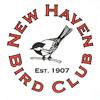Seventeen members of the New Haven Bird Club spent the day in our neighboring state of Rhode Island. We visited several outstanding birding locations and saw lots of great birds. The weather was unusually warm for this time of year, with the temperature ranging from 45 to 55 degrees. It was cloudy and breezy most of the day, but a light rain fell in the late afternoon.
Our first stop was at Beavertail State Park in Jamestown. Almost immediately after getting out of our cars, we saw three Razorbills swimming and diving off shore. Two of them stuck around for a long time, affording us excellent views of this remarkable alcid species. We also saw numerous Harlequin Duck and Common Eider here, as well as a few Purple Sandpipers and a Great Cormorant. We were off to a good start!
Our next stop was at Sachuest Point National Wildlife Refuge. The highlight here was not one, but two Snowy Owls. The first was roosting in a cleared field. The second was roosting on a rock along the beach close to the trail north of Island Rocks. We also saw Sanderling, Ruddy Turnstone, Purple Sandpiper, and all three Scoter species here.
Next, we went to Scarborough Beach State Park in Narragansett. It took some looking, but we were eventually able to find one of the Black-headed Gulls that have been seen there. It was feeding just offshore with lots of other gulls and waterfowl.
From there, we drove to Trustom Pond National Wildlife Refuge. We hiked from the ranger station to Osprey Point and observed the birds in the pond from the platform there. There was a nice variety of waterfowl in the pond, including Redhead, Greater and Lesser Scaup, Hooded Merganser, Gadwall, American Wigeon, and a Red-necked Grebe.
The rain had started to fall by then, so we stopped only briefly at Ninigret National Wildlife Refuge. But, that was long enough to find our old friend, the Lesser Black-backed Gull there. This particular individual has been wintering in the same cove at Grassy Point for the past 15 years or so. We are always glad to see this bird.
Our last stop, as the light was fading, was at the Weekapaug breachway. It took some time, but we eventually found the first year King Eider hidden in the Common Eider flock near the end of the canal. We also saw a female Black Scoter there.
All total, we observed 61 species on this fine day. We’ll be sure to head out there again next year!
Sincere thanks to all who participated on this long but satisfying trip.
Chris Loscalzo
